Spatial Variation of Acanthophlebia cruentata (Ephemeroptera), a Mayfly Endemic to Te Ika-a-Māui—North Island of Aotearoa, New Zealand
Abstract
:Simple Summary
Abstract
1. Introduction
2. Materials and Methods
2.1. Genetic Variation
2.2. Size Variation
3. Results
3.1. Diversity
3.2. Range Expansion
3.3. DNA-Barcode Data
3.4. Timeframe
3.5. Wing Length—Adult Size
4. Discussion
5. Conclusions
Supplementary Materials
Author Contributions
Funding
Institutional Review Board Statement
Informed Consent Statement
Data Availability Statement
Acknowledgments
Conflicts of Interest
References
- Winterbourn, M.J. The New Zealand stream invertebrates: An overview. In New Zealand Stream Invertebrates: Ecology and Implications for Management; Collier, K.J., Winterbourn, M.J., Eds.; New Zealand Limnological Society: Christchurch, New Zealand, 2000; pp. 11–29. [Google Scholar]
- Boothroyd, I.K.G. Biogeography and biodiversity. In New Zealand Stream Invertebrates: Ecology and Implications for Management; Collier, K.J., Winterbourn, M.J., Eds.; New Zealand Limnological Society: Christchurch, New Zealand, 2000; pp. 30–52. [Google Scholar]
- Taylor-Smith, B.; Morgan-Richards, M.; Trewick, S.A. Patterns of regional endemism among New Zealand invertebrates. N. Z. J. Zool. 2020, 47, 1–19. [Google Scholar] [CrossRef]
- Death, R.G.; Winterbourn, M.J. Diversity patterns in stream benthic invertebrate communities: The influence of habitat stability. Ecology 1995, 76, 1446–1460. [Google Scholar] [CrossRef]
- Hall, M.J.; Closs, G.P.; Riley, R.H. Relationships between land use and stream invertebrate community structure in a South Island, New Zealand, coastal stream catchment. N. Z. J. Mar. Freshw. Res. 2001, 35, 591–603. [Google Scholar] [CrossRef] [Green Version]
- Clapcott, J.; Young, R.; Goodwin, E.; Leathwick, J.; Kelly, D. Relationships between Multiple Land-Use Pressures and Individual and Combined Indicators of Stream Ecological Integrity; Research and Development Series; Department of Conservation: Wellington, New Zealand, 2011; p. 326.
- Williams, P.W.; McGlone, M.; Neil, H.; Zhao, J.-X. A review of New Zealand palaeoclimate from the last interglacial to the global last glacial maximum. Quat. Sci. Rev. 2015, 110, 92–106. [Google Scholar] [CrossRef]
- Avise, J.C. Phylogeography: Retrospect and prospect. J. Biogeog. 2009, 36, 3–15. [Google Scholar] [CrossRef] [Green Version]
- Pohe, S.R. An annotated checklist of New Zealand mayflies (Ephemeroptera), 2018. N. Z. Nat. Sci. 2018, 43, 1–20. [Google Scholar]
- Hitchings, T.R.; Hitchings, T.R. Two new species of Deleatidium (Deleatidium) (Ephemeroptera: Leptophlebiidae) from the central North Island of New Zealand. Rec. Cant. Mus. 2018, 32, 5–15. [Google Scholar]
- Pohe, S.R. Macroecology of New Zealand Ephemeroptera. Ph.D. Thesis, University of Canterbury, Christchurch, New Zealand, 2019. [Google Scholar]
- Hudson, G.V. New Zealand Neuroptera: A Popular Introduction to the Life-Histories and Habits of May-Flies, Dragon-Flies, Caddis-Flies and Allied Insects Inhabiting New Zealand, Including Notes on Their Relation to Angling; West, Newman & Co.: London, UK, 1904. [Google Scholar]
- Towns, D.R.; Peters, W.L. Leptophlebiidae (Insecta: Ephemeroptera). Fauna N. Z. 1996, 36, 144. [Google Scholar]
- O’Donnell, B.C.; Jockusch, E.L. Phylogenetic relationships of leptophlebiid mayflies as inferred by histone H3 and 28S ribosomal DNA. Syst. Entomol. 2008, 33, 651–667. [Google Scholar] [CrossRef]
- Harding, J.S.; Winterbourn, M.J. New Zealand Ecoregions: A Classification for Use in Stream Conservation and Management; DOC Technical Series No. 11; Department of Conservation: Wellington, New Zealand, 1997.
- Collier, K.J.; Quinn, J.M. Factors affecting distribution and abundance of the mayfly Acanthophlebia cruentata (Leptophlebiidae) in North Island, New Zealand, streams. N. Z. Entomol. 2004, 27, 17–28. [Google Scholar] [CrossRef]
- Smith, B.J.; Collier, K.J. Tolerances to diurnally varying temperature for three species of adult aquatic insects from New Zealand. Environ. Entomol. 2005, 34, 748–754. [Google Scholar] [CrossRef] [Green Version]
- McLean, J.A. Studies of Ephemeroptera in the Auckland area. Tane 1967, 13, 99–105. [Google Scholar]
- Trewick, S.A.; Bland, K.J. Fire and slice: Palaeogeography for biogeography at New Zealand’s North Island/South Island juncture. J. R. Soc. N. Z. 2012, 42, 153–183. [Google Scholar] [CrossRef]
- Trewick, S.A.; Pilkington, S.; Shepherd, L.D.; Gibb, G.C.; Morgan-Richards, M. Closing the gap: Avian lineage splits at a young, narrow seaway imply a protracted history of mixed population response. Mol. Ecol. 2017, 26, 5752–5772. [Google Scholar] [CrossRef]
- Bulgarella, M.; Trewick, S.A.; Minards, N.A.; Jacobson, M.J.; Morgan-Richards, M. Shifting ranges of two tree weta species (Hemideina spp.): Competitive exclusion and changing climate. J. Biog 2014, 41, 524–535. [Google Scholar]
- Morgan-Richards, M.; Langton-Myers, S.; Trewick, S.A. Loss and gain of sexual reproduction in the same stick insect. Mol. Ecol. 2019, 28, 3929–3941. [Google Scholar] [CrossRef] [Green Version]
- Trewick, S.A.; Wallis, G.P.; Morgan-Richards, M. The invertebrate life of New Zealand: A phylogeographic approach. Insects 2011, 2, 297–325. [Google Scholar] [CrossRef]
- Smith, P.J.; Collier, K.J. Allozyme diversity and population genetic structure of the caddisfly Orthopsyche fimbriata and the mayfly Acanthophlebia cruentata in New Zealand streams. Freshw. Biol. 2001, 46, 795–805. [Google Scholar] [CrossRef] [Green Version]
- Smith, P.J.; McVeagh, S.M.; Collier, K.J. Genetic diversity and historical population structure in the New Zealand mayfly Acanthophlebia cruentata. Freshw. Biol. 2006, 51, 12–24. [Google Scholar] [CrossRef]
- Newnham, R.; McGlone, M.; Moar, N.; Wilmshurst, J.; Vandergoes, M. The vegetation cover of New Zealand at the Last Glacial Maximum. Quat. Sci. Rev. 2013, 74, 202–214. [Google Scholar] [CrossRef]
- Morgan-Richards, M.; Trewick, S.A.; Stringer, I.A. Geographic parthenogenesis and the common tea-tree stick insect of New Zealand. Mol. Ecol. 2010, 19, 1227–1238. [Google Scholar] [CrossRef] [PubMed]
- Hogg, A.G.; Lowe, D.J.; Palmer, J.G.; Boswijk, G.; Ramsey, C.B. Revised calendar date for the Taupo eruption derived by 14C wiggle-matching using a New Zealand kauri 14C calibration data set. Holocene 2011, 22, 439–449. [Google Scholar] [CrossRef] [Green Version]
- Wilson, C.J.N.; Walker, G.P.L. The Taupo eruption, New Zealand. I. general aspects. Phil. Trans. R. Soc. A 1985, 314, 199–228. [Google Scholar]
- Morgan-Richards, M.; Trewick, S.A.; Wallis, G.P. Characterization of a hybrid zone between two chromosomal races of the weta Hemideina thoracica following a geologically recent volcanic eruption. Heredity 2000, 85, 586–592. [Google Scholar] [CrossRef]
- McDowall, R.M. Volcanism and freshwater fish biogeography in the northeastern North Island of New Zealand. J. Biogeog. 1996, 23, 139–148. [Google Scholar] [CrossRef] [Green Version]
- Slatkin, M.; Excoffier, L. Serial founder effects during range expansion: A spatial analog of genetic drift. Genetics 2012, 191, 171–181. [Google Scholar] [CrossRef] [Green Version]
- Waters, J.M.; Fraser, C.I.; Hewitt, G.M. Founder takes all: Density-dependent processes structure biodiversity. Trends Ecol. Evol. 2013, 28, 78–85. [Google Scholar] [CrossRef]
- Alloway, B.V.; Lowe, D.J.; Barrell, D.J.A.; Newnham, R.M.; Almond, P.C.; Augustinus, P.C.; Bertler, N.A.N.; Carter, L.; Litchfield, N.J.; McGlone, M.S.; et al. Towards a climate event stratigraphy for New Zealand over the past 30,000 years (NZ-INTIMATE project). J. Quat. Sci. 2007, 22, 9–35. [Google Scholar] [CrossRef]
- Wilson, C.J.N.; Leonard, G. Slumbering giants. In A Continent on the Move: New Zealand Geoscience into the 21st Century; Graham, I.J., Ed.; Geological Society of New Zealand Miscellaneous Publication: Wellington, New Zealand, 2008; Volume 124, pp. 166–169. [Google Scholar]
- Pohe, S.R.; Winterbourn, M.J.; Harding, J.S. Comparison of fluorescent lights with differing spectral properties on catches of adult aquatic and terrestrial insects. N. Z. Entomol. 2018, 41, 1–11. [Google Scholar] [CrossRef]
- Sunnucks, P.; Hales, D.F. Numerous transposed sequences of mitochondrial cytochrome oxidase I–II in aphids of the genus Sitobion (Hemiptera: Aphididae). Mol. Biol. Evol. 1996, 13, 510–524. [Google Scholar] [CrossRef]
- Simon, C.; Frati, F.; Beckenbach, A.; Crespi, B.; Liu, H.; Flook, P. Evolution, weighting, and phylogenetic utility of mitochondrial gene sequences and a compilation of conserved polymerase chain reaction primers. Ann. Entomol. Soc. Am. 1994, 87, 651–701. [Google Scholar] [CrossRef]
- Folmer, O.; Black, M.; Hoeh, W.; Lutz, R.; Vrijenhoek, R. DNA primers for amplification of mitochondrial cytochrome c oxidase subunit I from diverse metazoan invertebrates. Mol. Mar. Biol. Biotechnol. 1994, 3, 294–297. [Google Scholar] [PubMed]
- Kearse, M.; Moir, R.; Wilson, A.; Stones-Havas, S.; Cheung, M.; Sturrock, S.; Buxton, S.; Cooper, A.; Markowitz, S.; Duran, C.; et al. Geneious Basic: An integrated and extendable desktop software platform for the organization and analysis of sequence data. Bioinformatics 2012, 28, 1647–1649. [Google Scholar] [CrossRef] [PubMed]
- R Core Team. R: A Language and Environment for Statistical Computing; R Foundation for Statistical Computing: Vienna, Austria, 2021; Available online: https://www.R-project.org/ (accessed on 1 January 2022).
- Becker, R.A.; Wilks, A.R. R version by Ray Brownrigg. Enhancements by Thomas P Minka & Alex Deckmyn. 2018. Maps: Draw Geographical Maps. R Package Version 3.3.0. Available online: https://CRAN.R-project.org/package=maps (accessed on 1 January 2022).
- Bandelt, H.-J.; Forster, P.; Röhl, A. Median-joining networks for inferring intraspecific phylogenies. Mol. Biol. Evol. 1999, 16, 37–48. [Google Scholar] [CrossRef]
- Leigh, J.W.; Bryant, D. Popart: Full-feature software for haplotype network construction. Methods Ecol. Evolu. 2015, 6, 1110–1116. [Google Scholar] [CrossRef]
- Excoffier, L.; Foll, M.; Petit, R.J. Genetic consequences of range expansions. Anun. Rev. Ecol. Evol. Syst. 2009, 40, 481–501. [Google Scholar] [CrossRef]
- Jombart, T.; Devillard, S.; Dufour, A.-B.; Pontier, D. Revealing cryptic spatial patterns in genetic variability by a new multivariate method. Heredity 2008, 101, 92–103. [Google Scholar] [CrossRef] [Green Version]
- Jombart, T. Adegenet: A R package for the multivariate analysis of genetic markers. Bioinformatics 2008, 24, 1403–1405. [Google Scholar] [CrossRef] [Green Version]
- Excoffier, L.; Lischer, H.E. Arlequin suite ver 3.5: A new series of programs to perform population genetics analyses under Linux and Windows. Mol. Ecol. Res. 2010, 10, 564–567. [Google Scholar] [CrossRef]
- Charlesworth, B. Effective population size and patterns of molecular evolution and variation. Nat. Rev. Genet. 2009, 10, 195–205. [Google Scholar] [CrossRef]
- Rozas, J.; Ferrer-Mata, A.; Sánchez-DelBarrio, J.C.; Guirao-Rico, S.; Librado, P.; Ramos-Onsins, S.E.; Sánchez-Gracia, A. DnaSP 6: DNA Sequence Polymorphism Analysis of Large Datasets. Mol. Biol. Evol. 2017, 34, 3299–3302. [Google Scholar] [CrossRef] [PubMed]
- Rogers, A.R. Genetic evidence for a Pleistocene population explosion. Evolution 1995, 49, 608–615. [Google Scholar] [CrossRef] [PubMed]
- Rogers, A.R.; Harpending, H. Population growth makes waves in the distribution of pairwise genetic differences. Mol. Biol. Evol. 1992, 9, 552–569. [Google Scholar] [PubMed]
- Excoffier, L.; Smouse, P.E.; Quattro, J.M. Analysis of molecular variance inferred from metric distances among DNA haplotypes: Application to human mitochondrial DNA restriction data. Genetics 1992, 131, 479–491. [Google Scholar] [CrossRef]
- Dixon, P. VEGAN, A Package of R Functions for Community Ecology. J. Veget. Sci. 2003, 14, 927–930. [Google Scholar] [CrossRef]
- Wickman, P.-O.; Karlsson, B. Abdomen size, body size and the reproductive effort of insects. Oikos 1989, 56, 209–214. [Google Scholar] [CrossRef]
- Wickham, H. Ggplot2: Elegant Graphics for Data Analysis; Springer-Verlag: New York, NY, USA, 2016; ISBN 978-3-319-24277-4. [Google Scholar]
- Bates, D.M.; Mäechler, M.; Bolker, B.; Walker, S. Fitting Linear Mixed-Effects Models Using lme4. J. Stat. Softw. 2015, 67, 1–48. [Google Scholar] [CrossRef]
- Kuznetsova, A.; Brockhoff, P.B.; Christensen, R.H.B. lmerTest Package: Tests in Linear Mixed Effects Models. J. Stat. Softw. 2017, 82, 1–26. [Google Scholar] [CrossRef] [Green Version]
- Vannote, R.L.; Sweeney, B.W. Geographic analysis of thermal equilibria: A conceptual model for evaluating the effect of natural and modified thermal regimes on aquatic insect communities. Am. Nat. 1980, 115, 667–695. [Google Scholar] [CrossRef] [Green Version]
- Gratton, P.; Konopiński, M.K.; Sbordoni, V. Pleistocene evolutionary history of the Clouded Apollo (Parnassius mnemosyne): Genetic signatures of climate cycles and a ‘time-dependent’ mitochondrial substitution rate. Mol. Ecol. 2008, 17, 4248–4262. [Google Scholar] [CrossRef] [Green Version]
- Ney, G.; Frederick, K.; Schul, J. A post-Pleistocene calibrated mutation rate from insect museum specimens. PLoS Curr. 2018, 10, 565cf35. [Google Scholar] [CrossRef] [PubMed]
- Rother, H.; Fink, D.; Shulmeister, J.; Mifsud, C.; Evans, M.; Pugh, J. The early rise and late demise of New Zealand’s last glacial maximum. Proc. Natl. Acad. Sci. USA 2014, 111, 11630–11635. [Google Scholar] [CrossRef] [PubMed] [Green Version]
- Beet, C.R. Assessing the Diversity of Antarctic and New Zealand Arthropods through DNA Barcoding. Master’s Thesis, University of Waikato, Hamilton, New Zealand, 2016. [Google Scholar]
- Pohe, S.R.; Winterbourn, M.J.; Goldstien, S.J.; Ball, O.J.-P.; Harding, J.S. Distribution, nymphal habitat, genetic structure and conservation of the New Zealand mayfly Isothraulus abditus (Insecta: Ephemeroptera) and a description of its subimago. N. Z. J. Zool. 2019, 46, 13–30. [Google Scholar] [CrossRef]
- Morgan-Richards, M.; Bulgarella, M.; Sivyer, L.; Dowle, E.J.; Hale, M.; McKean, N.E.; Trewick, S.A. Explaining large mitochondrial sequence differences within a population sample. R. Soc. Open Sci. 2017, 4, 170730. [Google Scholar] [CrossRef] [Green Version]
- Chappell, E.M.; Trewick, S.A.; Morgan-Richards, M. Shape and sound reveal genetic cohesion not speciation in the New Zealand orthopteran, Hemiandrus pallitarsis, despite high mitochondrial DNA divergence. Biol. J. Linn. Soc. 2012, 105, 169–186. [Google Scholar] [CrossRef] [Green Version]
- Collier, K.J.; Wright-Stow, A.E.; Smith, B.J. Trophic basis of production for a mayfly in a North Island, New Zealand, forest stream: Contributions of benthic versus hyporheic habitats and implications for restoration. N. Z. J. Mar. Freshw. Res. 2004, 38, 301–314. [Google Scholar] [CrossRef]
- Harrison, R.G. Animal mitochondrial DNA as a genetic marker in population and evolutionary biology. Trends Ecol. Evol. 1989, 4, 6–11. [Google Scholar] [CrossRef]
- Shulmeister, J.; Thackray, G.D.; Rittenour, T.M.; Fink, D.; Patton, N.R. The timing and nature of the last glacial cycle in New Zealand. Quat. Sci. Rev. 2019, 206, 1–20. [Google Scholar] [CrossRef]
- Wilmshurst, J.M.; McGlone, M.S. Forest disturbance in the central North Island, New Zealand, following the 1850 BP Taupo eruption. Holocene 1996, 6, 399–411. [Google Scholar] [CrossRef]
- Morgan-Richards, M.; Trewick, S.A.; Wallis, G.P. Chromosome races with Pliocene origins: Evidence from mtDNA. Heredity 2001, 86, 303–312. [Google Scholar] [CrossRef]
- Painting, C.J.; Myers, S.; Holwell, G.I.; Buckley, T.R. Phylogeography of the New Zealand giraffe weevil Lasiorhynchus barbicornis (Coleoptera: Brentidae): A comparison of biogeographic boundaries. Biol. J. Linn. Soc. 2017, 122, 13–28. [Google Scholar] [CrossRef]
- Ellis, E.A.; Marshall, D.C.; Hill, K.B.R.; Owen, C.L.; Kamp, P.J.J.; Simon, C. Phylogeography of six codistributed New Zealand cicadas and their relationship to multiple biogeographic boundaries suggest a re-evaluation of the Taupo Line. J. Biogeog. 2015, 42, 1761–1775. [Google Scholar] [CrossRef] [Green Version]
- Kosnicki, E.; Burian, S. Life history aspects of the mayfly Siphlonurus typicus (Ephemeroptera: Siphlonuridae) with a new application for measuring nymphal development and growth. Hydrobiologia 2003, 510, 131–146. [Google Scholar] [CrossRef]
- Wessel, A.; Hoch, H.; Asche, M.; Howarth, F.G. Founder effects initiated rapid species radiation in Hawaiian cave planthoppers. Proc. Natl. Acad. Sci. USA 2013, 110, 9391–9396. [Google Scholar] [CrossRef] [PubMed] [Green Version]
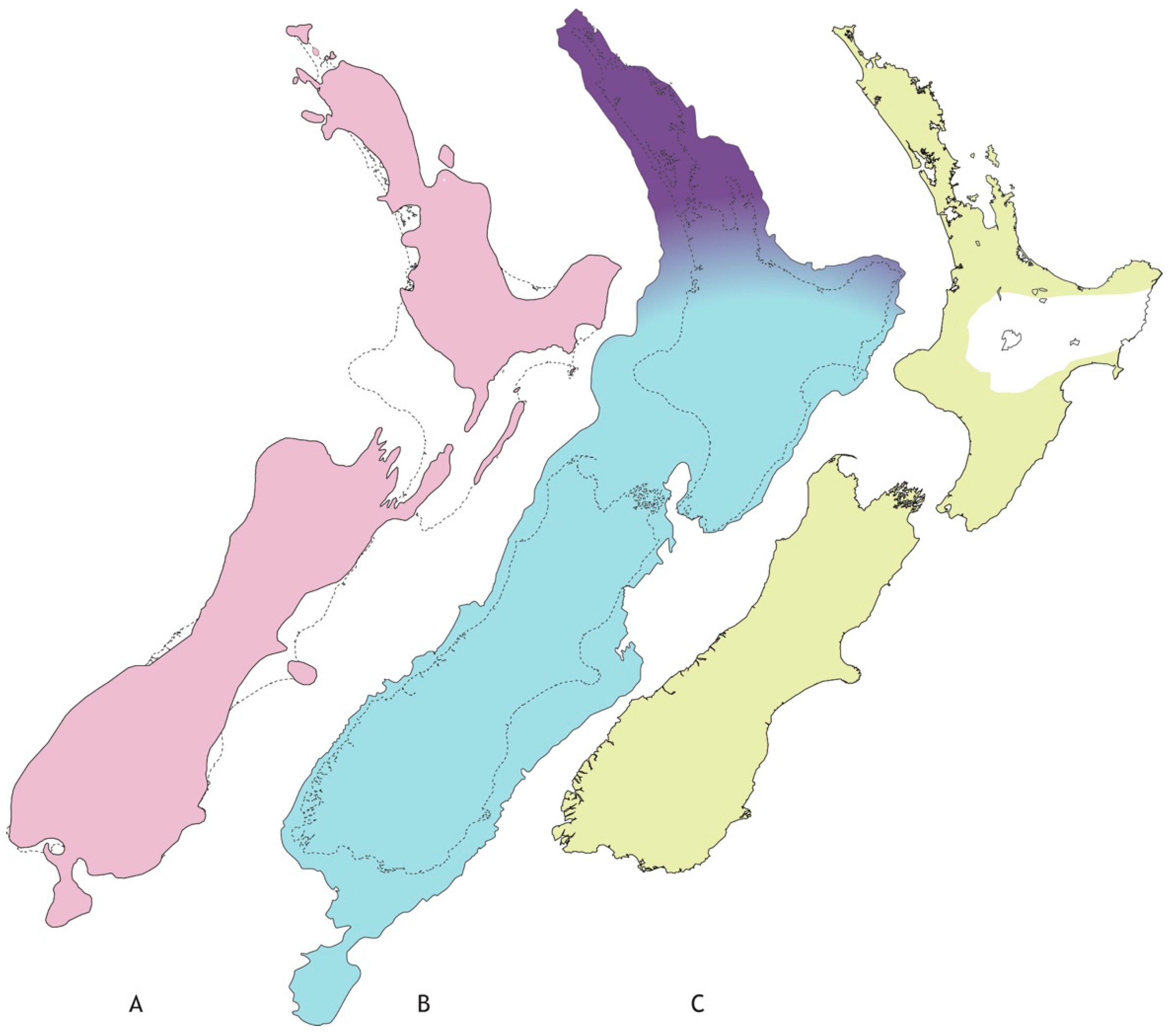
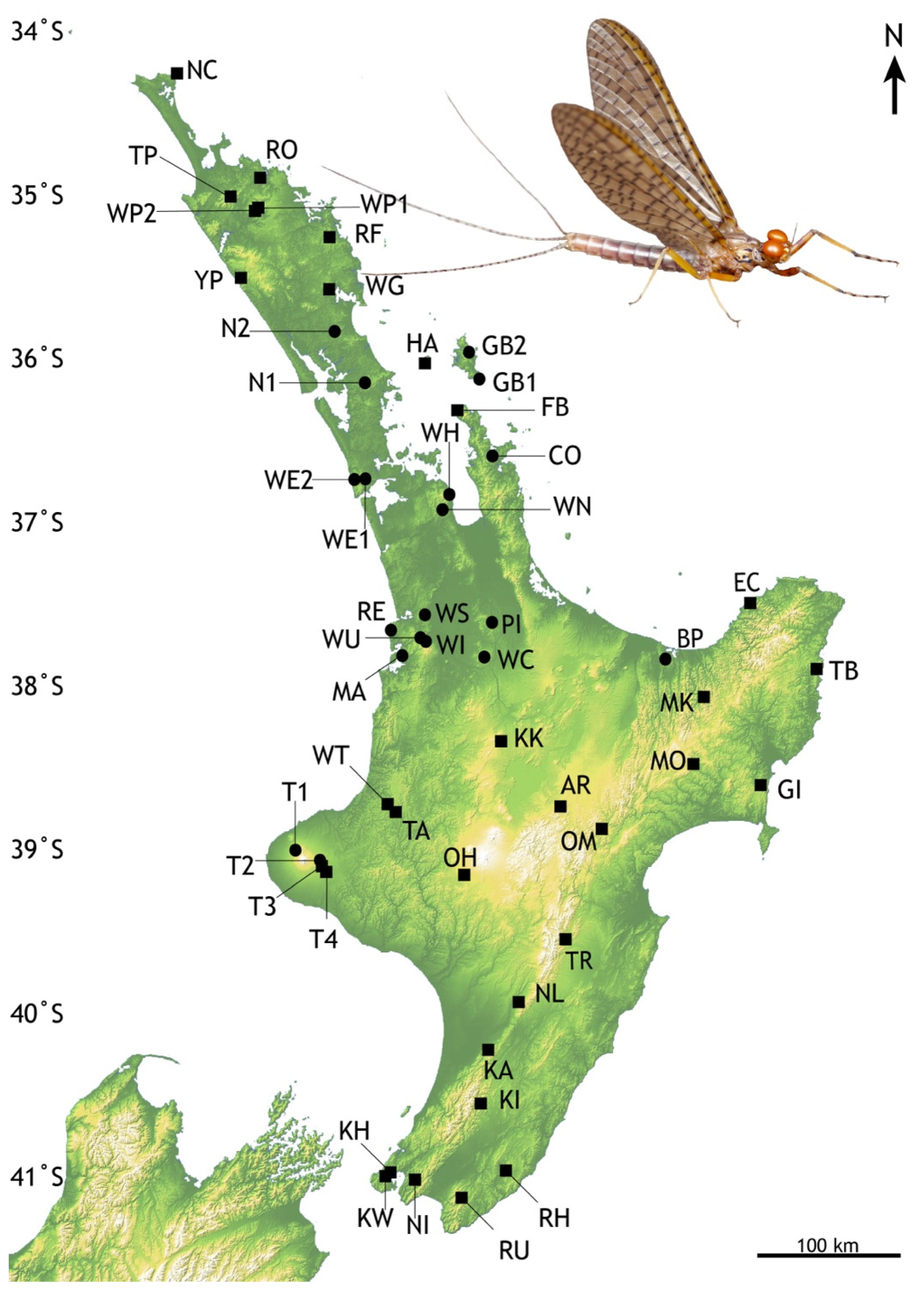
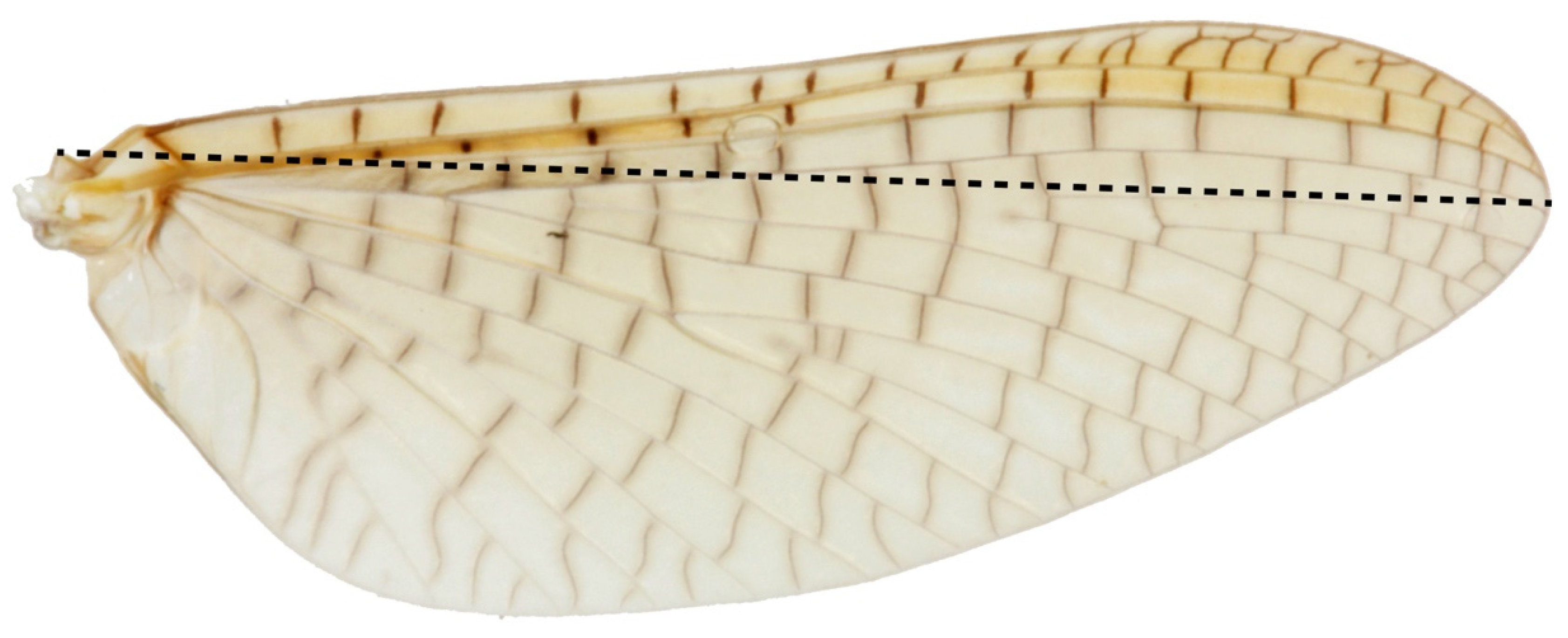
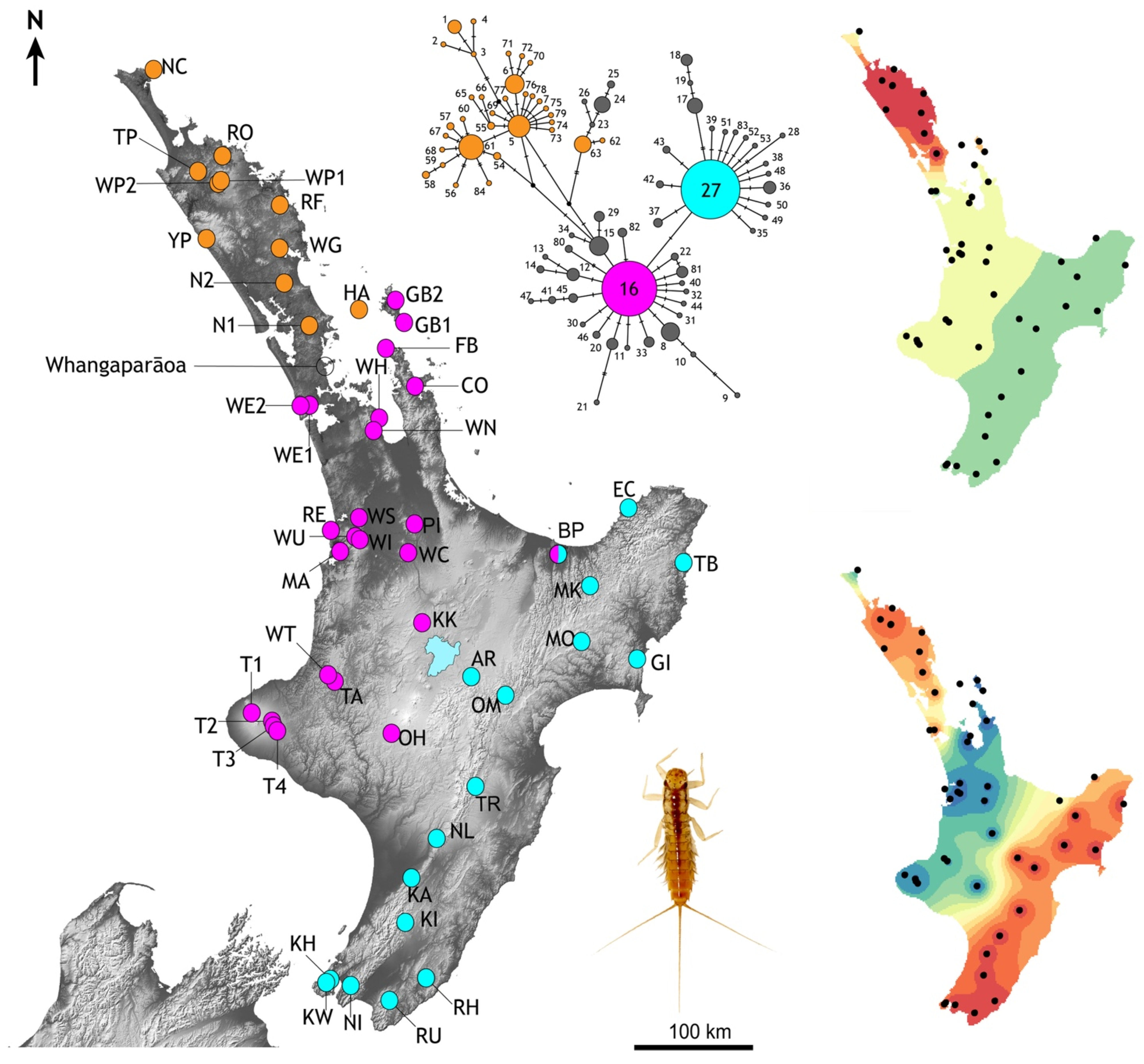
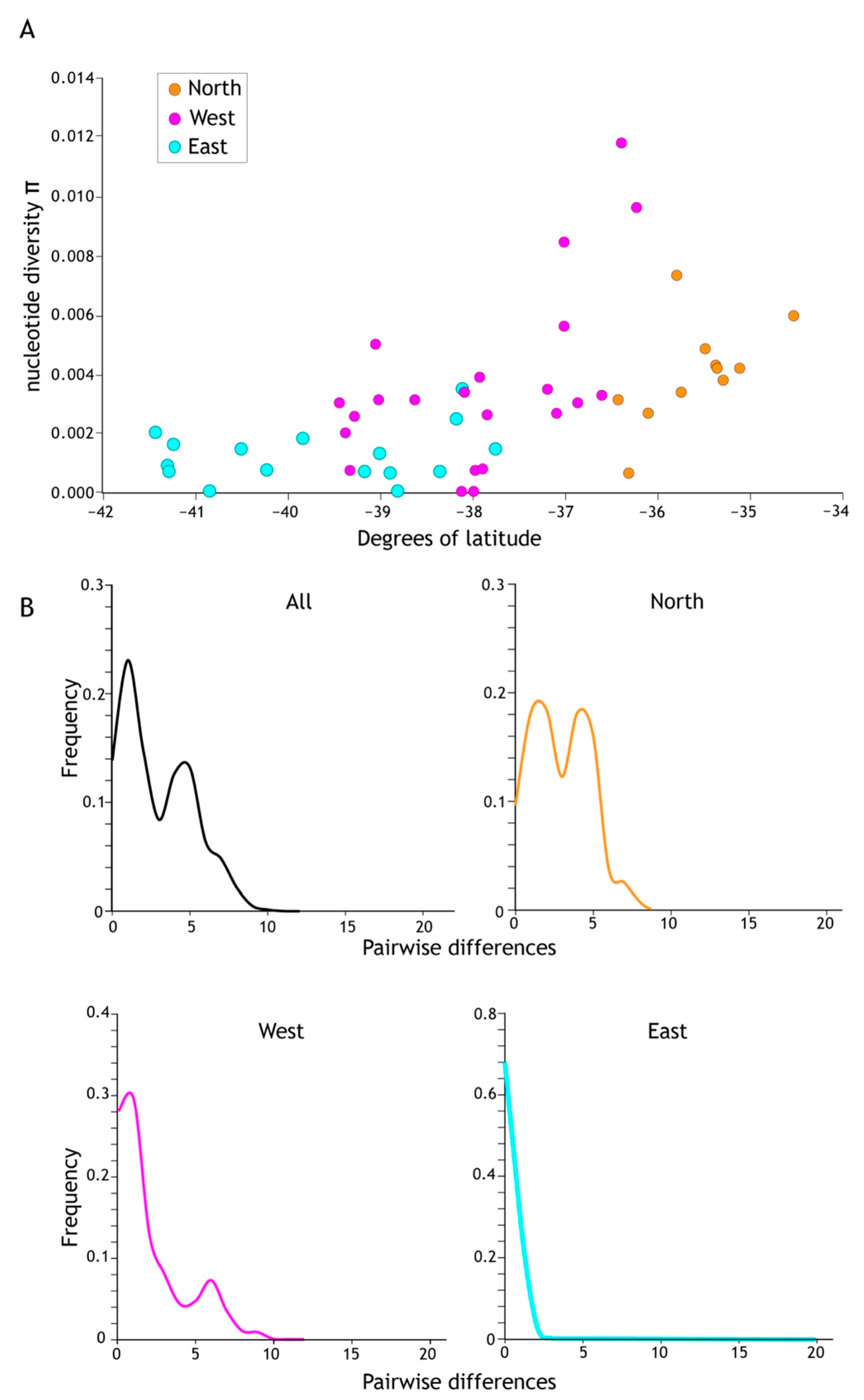
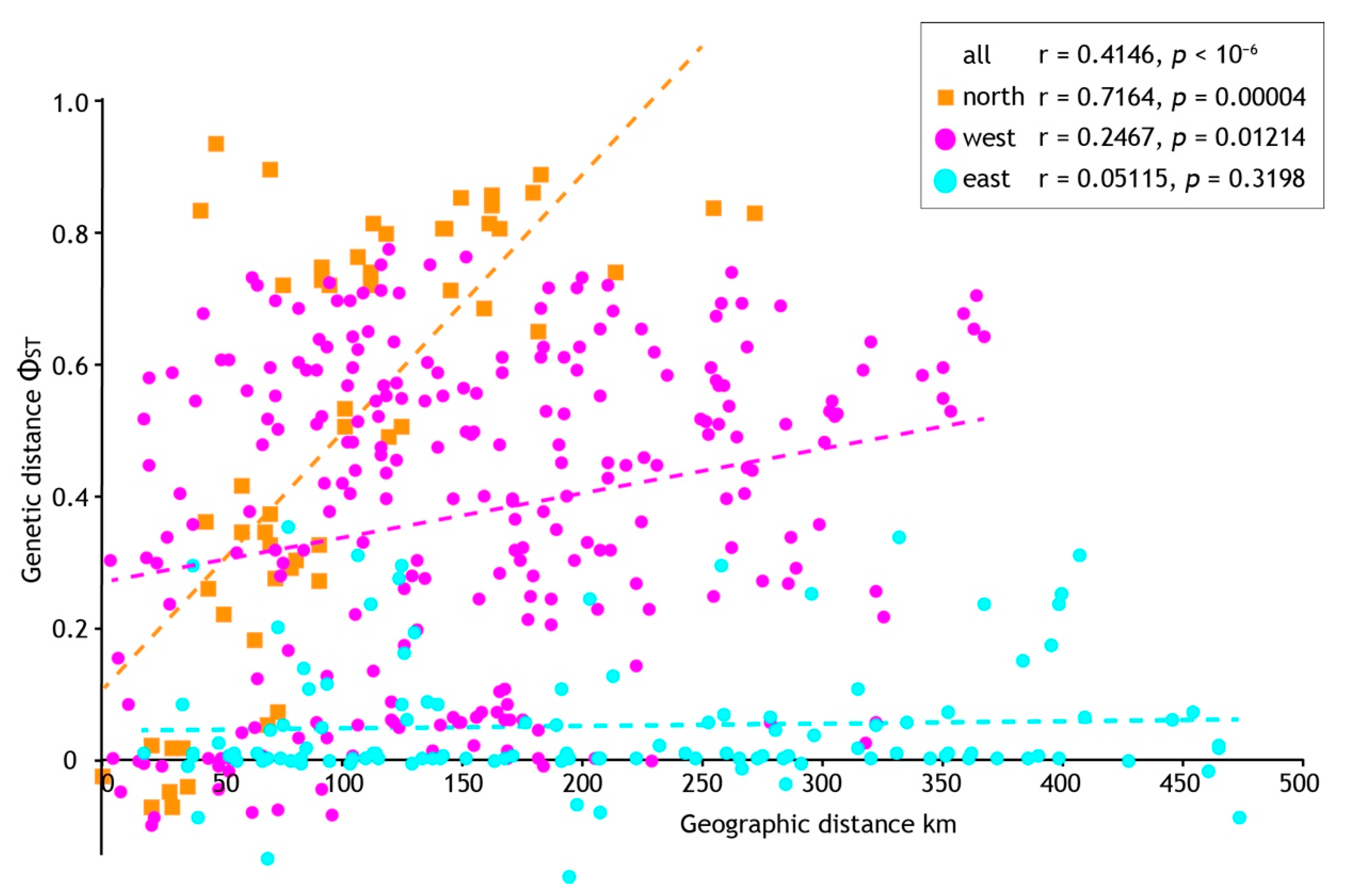

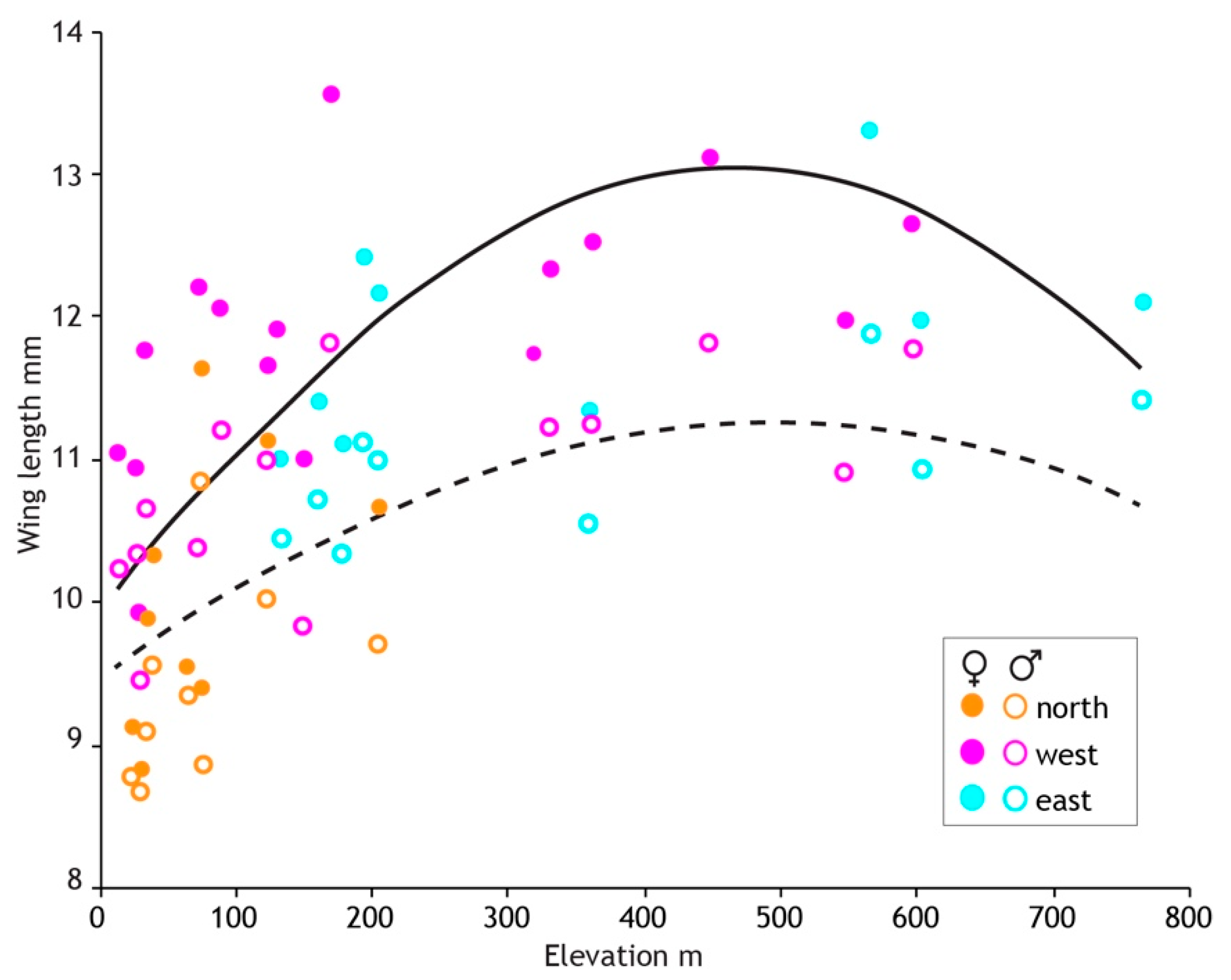
| Site | Stream/Location | N | Catchment | Region | Latitude | Longitude |
|---|---|---|---|---|---|---|
| NC | Whiriwhiri | 8 | Great Exhibition Bay | north | −34.41618 | 173.02423 |
| RO | Waiarakau, Whangaroa | 10 | Pekapeka Bay | north | −35.01494 | 173.71780 |
| TP | Tapapa | 7 | Mangamuka | north | −35.190923 | 173.479886 |
| WP1 | Un-named | 10 | Waipapa | north | −35.268508 | 173.69025 |
| WP2 | Opaopao | 13 | Waipapa | north | −35.275884 | 173.684116 |
| RF | Punaruku, Russell Forest | 11 | Whangaruru Harbour | north | −35.39779 | 174.31114 |
| YP | Waipoua | 12 | Waipoua | north | −35.65149 | 173.55684 |
| WG | Un-named, Pukenui Forest | 12 | Whangarei | north | −35.70250 | 174.26365 |
| N2 | Kaikowhiti | 10 | 2 Manganui | north | −36.026502 | 174.324863 |
| HA2 | Haowhenua | 6 | Hauraki Gulf | north | −36.204798 | 175.050593 |
| HA1 | Awaroa | 6 | Hauraki Gulf | north | −36.226593 | 175.083970 |
| N1 | Waitaraire | 10 | 1 Hoteo | north | −36.343918 | 174.570645 |
| GB2 | Un-named | 10 | 6 Un-named | west | −36.15232 | 175.422072 |
| GB1 | Un-named | 10 | 5 Un-named | west | −36.316537 | 175.53457 |
| FB | Fantail | 12 | Fantail Bay | west | −36.524012 | 175.329540 |
| CO | Whangapoua | 9 | 8 Whangapoua | west | −36.790841 | 175.606381 |
| WE1 | Nihotupu | 9 | 3 Nihotupu | west | −36.936229 | 174.558453 |
| WE2 | Marawhara | 10 | 4 Marawhara | west | −36.940233 | 174.467602 |
| WH | Whaharau | 10 | 7 Whaharau | west | −37.030701 | 175.27899 |
| WN | Mangatangi | 9 | 10 Waikato | west | −37.124688 | 175.223497 |
| WS | Whatawhata | 11 | 10 Waipa; Waikato | west | −37.777573 | 175.070591 |
| PI | Piakonui | 9 | 11 Piakonui | west | −37.827104 | 175.626659 |
| RE | Te Rekereke | 10 | 12 Te Rekereke | west | −37.869378 | 174.768631 |
| WU | Paiaka | 10 | 9 Waitetuna | west | −37.915366 | 175.028061 |
| WI | Kaniwhaniwha | 10 | 10 Waipa; Waikato | west | −37.937943 | 175.074245 |
| MA | Mangaroa | 8 | 13 Mangaroa | west | −38.026209 | 174.876355 |
| WC | Mangatautari | 10 | 10 Waikato | west | −38.053945 | 175.563346 |
| KK | Kakaho | 7 | Waikato | west | −38.569143 | 175.717612 |
| WT | Waitara | 7 | Waitara | west | −38.96487 | 174.756806 |
| TA | Tangarakau | 12 | Whanganui | west | −39.006367 | 174.818337 |
| T2 | Katikara | 11 | 16 Katikara | west | −39.224687 | 173.966536 |
| T3 | Waipuku | 9 | Waitara | west | −39.288286 | 174.175361 |
| T1 | Patea | 10 | 15 Patea | west | −39.324293 | 174.19069 |
| T4 | Waingongoro | 1 | Waingongoro River | west | −39.36037 | 174.227564 |
| OH | Mangawhero (Ohakune) | 11 | Whangaehu | west | −39.400426 | 175.41362 |
| EC | Whanarua | 5 | Un-named | east | −37.679337 | 177.765742 |
| BP | Wainui | 10 | 14 Wainui | east | −38.052137 | 177.06847 |
| TB | Waihi | 8 | Tokomaru Bay | east | −38.105271 | 178.351447 |
| MK | Manganuku | 11 | Opatato/Waioeka | east | −38.289889 | 177.385076 |
| MO | Ruapapa | 12 | L. Waikaremoana | east | −38.754575 | 177.162035 |
| GI | Te Arai | 12 | Gisborne | east | −38.82820 | 177.78960 |
| AR | Te Arero | 10 | L. Taupo; Waikato | east | −38.955119 | 176.226307 |
| OM | Omarowa | 11 | Mohaka | east | −39.110777 | 176.563837 |
| TR | Triplex | 12 | Tukituki | east | −39.783281 | 176.26527 |
| NL | Matanganui (No 1 Line) | 11 | Manawatu | east | −40.185977 | 175.868259 |
| KA | Kahuterawa | 10 | Manawatu | east | −40.472337 | 175.608022 |
| KI | Kiriwhakapapa | 11 | Ruamahanga | east | −40.808855 | 175.545166 |
| RH | Waipunga (Rocky Hills) | 9 | Pahaoa | east | −41.214914 | 175.77028 |
| KH | Tyers (upper), Khandallah | 1 | Wellington Harbour | east | −41.241352 | 174.787612 |
| KW | Kaiwharawhara | 12 | Kaiwharawhara | east | −41.265569 | 174.75777 |
| NI | Nikau | 8 | Wainuiomata | east | −41.27658 | 174.973306 |
| RU | Ruakokoputuna | 11 | Ruamahanga | east | −41.403603 | 175.36374 |
| Site | Region | N | h | Hd | π |
|---|---|---|---|---|---|
| N1 | north | 10 | 4 | 0.5333 | 0.0031 |
| N2 | north | 10 | 3 | 0.6000 | 0.0026 |
| WP1 | north | 10 | 6 | 0.7778 | 0.0041 |
| WP2 | north | 13 | 5 | 0.6282 | 0.0042 |
| TP | north | 7 | 3 | 0.6667 | 0.0037 |
| YP | north | 12 | 6 | 0.6818 | 0.0034 |
| HA1 | north | 12 | 2 | 0.1667 | 0.0006 |
| NC | north | 8 | 3 | 0.6071 | 0.0059 |
| RF | north | 11 | 6 | 0.8000 | 0.0048 |
| RO | north | 10 | 5 | 0.6667 | 0.0041 |
| WG | north | 12 | 8 | 0.8485 | 0.0073 |
| WE1 | west | 9 | 4 | 0.6944 | 0.0056 |
| WE2 | west | 10 | 3 | 0.7333 | 0.0083 |
| GB1 | west | 10 | 4 | 0.7111 | 0.0117 |
| GB2 | west | 9 | 4 | 0.6944 | 0.0095 |
| WH | west | 10 | 3 | 0.6000 | 0.0026 |
| CO | west | 9 | 4 | 0.6944 | 0.0030 |
| WU | west | 10 | 2 | 0.2000 | 0.0007 |
| WN | west | 10 | 4 | 0.5333 | 0.0034 |
| WC | west | 9 | 1 | 0.0000 | 0.0000 |
| WS | west | 11 | 5 | 0.6182 | 0.0026 |
| WI | west | 10 | 1 | 0.0000 | 0.0000 |
| PI | west | 9 | 2 | 0.2222 | 0.0008 |
| RE | west | 10 | 2 | 0.5333 | 0.0038 |
| MA | west | 8 | 3 | 0.6071 | 0.0033 |
| T1 | west | 9 | 2 | 0.5556 | 0.0020 |
| T2 | west | 12 | 3 | 0.6212 | 0.0025 |
| T3 | west | 10 | 2 | 0.2000 | 0.0007 |
| WT | west | 7 | 3 | 0.6667 | 0.0031 |
| TA | west | 12 | 7 | 0.8636 | 0.0049 |
| OH | west | 11 | 3 | 0.4727 | 0.0030 |
| KK | west | 7 | 2 | 0.2857 | 0.0031 |
| FB | west | 12 | 4 | 0.6364 | 0.0033 |
| BP | east | 10 | 3 | 0.6444 | 0.0034 |
| EC | east | 5 | 2 | 0.4000 | 0.0014 |
| TR | east | 12 | 4 | 0.4546 | 0.0018 |
| NL | east | 10 | 2 | 0.2000 | 0.0007 |
| KA | east | 10 | 3 | 0.3778 | 0.0014 |
| KI | east | 11 | 1 | 0.0000 | 0.0000 |
| RH | east | 9 | 3 | 0.4167 | 0.0016 |
| KW | east | 11 | 2 | 0.1818 | 0.0007 |
| NI | east | 8 | 2 | 0.2500 | 0.0009 |
| OM | east | 11 | 2 | 0.1818 | 0.0007 |
| AR | east | 10 | 2 | 0.3556 | 0.0013 |
| MK | east | 11 | 2 | 0.1818 | 0.0007 |
| TB | east | 8 | 3 | 0.6071 | 0.0024 |
| RU | east | 11 | 4 | 0.4909 | 0.0020 |
| GI | east | 12 | 2 | 0.1667 | 0.0006 |
| MO | east | 12 | 1 | 0.0000 | 0.0000 |
| Total Data Estimates | 490 | 83 | 0.8611 | 0.0103 |
| N | π | k | S | h | Hd | Tajima’s D | p | Ramos-Onsins & Rozas’s R2 | Raggedness r | |
|---|---|---|---|---|---|---|---|---|---|---|
| All | 492 | 0.01034 | 2.8951 | 63 | 83 | 0.8606 | −1.9460 | <0.05 | 0.0246 | 0.0270 |
| north | 115 | 0.01045 | 2.9616 | 31 | 36 | 0.9040 | −1.5488 | >0.10 | 0.0441 | 0.0307 |
| west | 207 | 0.00731 | 2.0459 | 32 | 34 | 0.7197 | −1.7683 | <0.05 | 0.0307 | 0.0337 |
| east | 162 | 0.00126 | 0.0354 | 17 | 17 | 0.3145 | −2.3518 | <0.01 | 0.0178 | 0.2263 |
| MALE | FEMALE | |||
|---|---|---|---|---|
| Fixed Effects Fitted Parameters | p | Fixed Effects Fitted Parameters | p | |
| Intercept | 2.26370 | <2 × 10−16 | 2.38685 | <2 × 10−16 |
| Week2 | −0.00073 | 0.04461 | ||
| Elevation | 0.07004 | 3.047 × 10−5 | 0.11694 | 5.946 × 10−7 |
| Elevation2 | −0.00706 | 0.001713 | −0.01258 | 2.375 × 10−5 |
| Region | 0.001240 | 0.0004293 | ||
| north | −0.07063 | −0.14241 | ||
| west | 0.02076 | 0.02467 | ||
Publisher’s Note: MDPI stays neutral with regard to jurisdictional claims in published maps and institutional affiliations. |
© 2022 by the authors. Licensee MDPI, Basel, Switzerland. This article is an open access article distributed under the terms and conditions of the Creative Commons Attribution (CC BY) license (https://creativecommons.org/licenses/by/4.0/).
Share and Cite
Trewick, S.A.; Henderson, I.M.; Pohe, S.R.; Morgan-Richards, M. Spatial Variation of Acanthophlebia cruentata (Ephemeroptera), a Mayfly Endemic to Te Ika-a-Māui—North Island of Aotearoa, New Zealand. Insects 2022, 13, 567. https://doi.org/10.3390/insects13070567
Trewick SA, Henderson IM, Pohe SR, Morgan-Richards M. Spatial Variation of Acanthophlebia cruentata (Ephemeroptera), a Mayfly Endemic to Te Ika-a-Māui—North Island of Aotearoa, New Zealand. Insects. 2022; 13(7):567. https://doi.org/10.3390/insects13070567
Chicago/Turabian StyleTrewick, Steven A., Ian M. Henderson, Stephen R. Pohe, and Mary Morgan-Richards. 2022. "Spatial Variation of Acanthophlebia cruentata (Ephemeroptera), a Mayfly Endemic to Te Ika-a-Māui—North Island of Aotearoa, New Zealand" Insects 13, no. 7: 567. https://doi.org/10.3390/insects13070567
APA StyleTrewick, S. A., Henderson, I. M., Pohe, S. R., & Morgan-Richards, M. (2022). Spatial Variation of Acanthophlebia cruentata (Ephemeroptera), a Mayfly Endemic to Te Ika-a-Māui—North Island of Aotearoa, New Zealand. Insects, 13(7), 567. https://doi.org/10.3390/insects13070567







